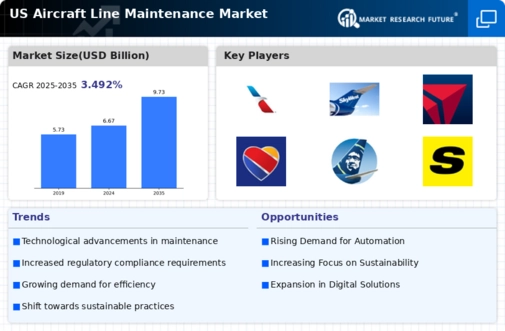Increasing Air Traffic Demand
The aircraft line-maintenance market is experiencing growth driven by the rising demand for air travel in the United States. As more passengers opt for air travel, airlines are expanding their fleets to accommodate this surge. According to the Federal Aviation Administration (FAA), air traffic is projected to increase by approximately 3.5% annually over the next decade. This growth necessitates enhanced line-maintenance services to ensure aircraft safety and reliability. Airlines are investing in maintenance capabilities to minimize downtime and maximize operational efficiency. Consequently, The aircraft line-maintenance market will benefit from this trend, as airlines seek to maintain their fleets in optimal condition to meet increasing passenger demand.
Expansion of Low-Cost Carriers
The proliferation of low-cost carriers (LCCs) in the United States significantly impacts the aircraft line-maintenance market. LCCs typically operate on thin profit margins, which compels them to seek cost-effective maintenance solutions. This trend has led to an increase in demand for third-party line-maintenance providers who can offer competitive pricing without compromising safety. According to industry reports, LCCs are projected to capture over 40% of the domestic market share by 2026. As these carriers expand their operations, the aircraft line-maintenance market is likely to see a corresponding increase in demand for efficient and affordable maintenance services.
Regulatory Changes and Compliance Requirements
Evolving regulatory changes and compliance requirements set forth by aviation authorities influence the aircraft line-maintenance market. The FAA continuously updates regulations to enhance safety standards, which necessitates that airlines and maintenance providers adapt their practices accordingly. Compliance with these regulations often requires additional training and investment in maintenance infrastructure. As a result, the market is expected to see increased demand for line-maintenance services that can ensure adherence to these stringent regulations. This dynamic creates opportunities for service providers who can offer expertise in navigating the complex regulatory landscape.
Focus on Operational Efficiency and Cost Reduction
In the competitive landscape of the aviation industry, airlines increasingly focus on operational efficiency and cost reduction. This emphasis drives the demand for effective line-maintenance solutions that minimize aircraft downtime and optimize maintenance schedules. Airlines are adopting lean maintenance practices to streamline operations and reduce costs associated with unscheduled maintenance. The aircraft line-maintenance market is likely to benefit from this trend, as airlines seek to implement strategies that enhance their operational performance. By investing in efficient maintenance processes, airlines can improve their bottom line while ensuring the safety and reliability of their fleets.
Technological Integration in Maintenance Processes
The integration of advanced technologies in maintenance processes drives the aircraft line-maintenance market. Innovations such as predictive maintenance, artificial intelligence, and data analytics are transforming how maintenance is conducted. These technologies enable airlines to anticipate maintenance needs, thereby reducing unexpected failures and enhancing safety. The FAA has noted that predictive maintenance can lead to a reduction in maintenance costs by up to 30%. As airlines adopt these technologies, the demand for specialized line-maintenance services is expected to rise, creating opportunities for service providers in the aircraft line-maintenance market.
























Leave a Comment